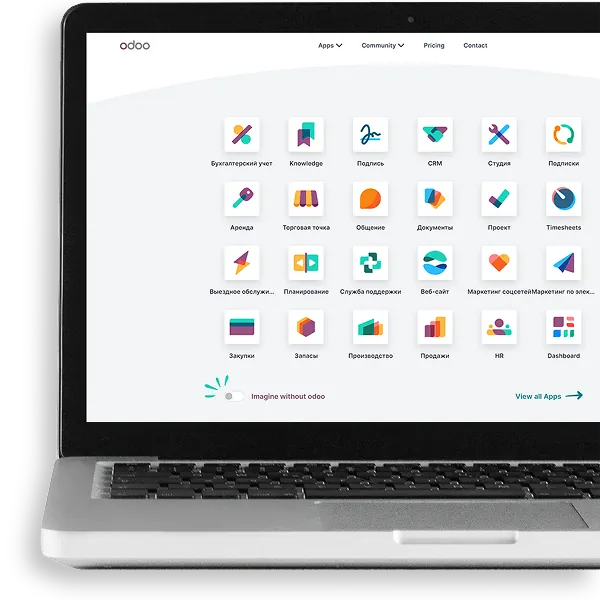Warehouse automation
When a warehouse functions as a well-oiled machine, business grows faster, orders are shipped without delays, and customers come back again. That is why a warehouse management system is not a luxury, but a necessity for those who want to work efficiently. The Odoo warehouse management program allows you to transform chaos into a system where each unit of goods is easily tracked and each stage is under control.

Which businesses need a WMS warehouse management system?
A WMS system for a warehouse is suitable for business projects where the warehouse is the main element of logistics. In such companies, turnover is measured in hundreds and thousands of items per day. If a large number of people work in the warehouse and the accounting is done manually or via Excel, a WMS system helps to avoid mistakes and time loss.
The program for warehouse accounting can be involved in various industries. It is suitable for use in:
- retail;
- distribution;
- e-commerce;
- pharmaceuticals;
- production;
- construction;
- transportation;
- communication;
- in the field of 3PL logistics.
In these industries, the quantity of goods, control of expiration dates, fast order picking, and real-time tracking of balances are important.

The system is also relevant for companies that are actively scaling up or planning to open new warehouses. The WMS system allows you to quickly train staff, unify processes, and reduce dependence on the human factor. This is important in the face of growing order volumes or high staff turnover.

Which businesses need a WMS warehouse management system?
A WMS system for a warehouse is suitable for business projects where the warehouse is the main element of logistics. In such companies, turnover is measured in hundreds and thousands of items per day. If a large number of people work in the warehouse and the accounting is done manually or via Excel, a WMS system helps to avoid mistakes and time loss.
The program for warehouse accounting can be involved in various industries. It is suitable for use in:
Retail
Distributions
E-commerce
Pharmaceuticals
Production
Construction
Transportation
Communications.
In the field of 3PL logistics
In these industries, the quantity of goods, control of expiration dates, fast order picking, and real-time tracking of balances are important.
The system is also relevant for companies that are actively scaling up or planning to open new warehouses. The WMS system allows you to quickly train staff, unify processes, and reduce dependence on the human factor. This is important in the face of growing order volumes or high staff turnover.
Want to try Odoo and learn more?
Comprehensive warehouse automation with Odoo
Implementing Odoo is a practical step for those who want to put their inventory in order and work smoothly. When everything is set up correctly, goods are not lost, and daily tasks are solved quickly. The Odoo CRM warehouse automation program helps to make these processes convenient and understandable.
What warehouse automation tasks can Odoo solve?
One of the main solutions offered by warehouse process automation is working with barcodes. The system allows you to generate unique codes for individual products and entire groups. They can be placed on labels and price tags, providing quick reading of product information using a scanner.
Posting and writing off are also important tools. With Odoo CRM, you can:
- indicate the warranty, both from the supplier and internal;
- add photos of products;
- manage prices.
You can use a barcode, article number, name, or serial number to find the item you need.
The ability to perform group actions with goods helps to save time. You can select the necessary items for moving between warehouses, writing off, selling, or changing the category. This is suitable for companies where goods are often moved or need to be redistributed.
Documents are printed by customizing templates for price tags, labels, or serial numbers. This speeds up the preparation of goods for sale and reduces the likelihood of labeling errors.
What is included in warehouse logistics automation?
Warehouse logistics automation means implementing digital solutions that simplify the accounting, storage, movement, and handling of goods in the warehouse. It all starts with electronic inventory control: the system shows in real time
Number of units of each product in stock
Their location.
The time when you need to make a deposit.
After that, the products are accepted and shipped. Automation allows you to quickly scan barcodes or serial numbers. The system then records the receipt or issue, automatically updates the balances, and generates the relevant documents.
The software helps to process orders by distributing goods, suggesting the best collection routes, and suggesting which warehouse to ship from. Using automation, you can generate reports, control expiration dates, warranty, placement of goods according to categories, weight, or frequency of sales. As a result, the warehouse operates without confusion and downtime, and the business controls logistics without wasting time and resources.
What does warehouse automation in the Odoo system cover?
Automation of warehouse accounting in the Odoo CRM system covers the main processes related to the movement and storage of goods. Thanks to its use, it is possible to:
- Keep accurate records of balances.
- Automatically update the data after each acceptance or shipment.
- Reduce the risk of errors during inventory.
The system allows you to add new products, where you can specify not only the name or article, but also a photo, warranty, serial number, storage conditions, and other important information. Odoo supports search by several parameters, which improves warehouse management. The program allows you to create barcodes, print labels, customize document templates, and perform group operations. The system also records when the goods arrived, who received them, where they are stored, and in what condition.
How does warehouse automation help reduce costs?
Automation of warehouse operations helps to efficiently manage resources, avoid mistakes, and reduce time spent on routine tasks. Thanks to electronic accounting, every action with the goods is recorded automatically: the system knows what exactly has been received, where it is stored, when it was sold or written off. This reduces the risk of information loss due to human error.
The Odoo CRM system can tell you when you need to replenish stocks. It also helps to avoid both overstocks and shortages that could lead to losses or loss of customers. Thanks to control, automated document printing, and the ability to perform group operations, the processing time for each action is reduced.
Want to try Odoo and learn more?
What functions does the warehouse management system cover?
For a warehouse to operate as a well-oiled machine, it is important to have a complete set of tools for accounting, control, and operational work with goods. The WMS system offers a comprehensive solution that covers the main functions:
Product and inventory management:
- Nomenclature.
- Batch accounting.
- Serial accounting.
- Addressed storage.
- Accounting for expiration dates and packages.
- Product codes.
- Barcodes.
- Reservation of goods.
- Inventory level control with customizable notifications.
- Monitoring the availability in warehouses.
- Formation of the inventory list.
- Assortment analysis (popular items, demand).
- Additional warehouses with product categorization.
- Possibility of accounting for medicines and spare parts.
Operations with goods:
- Import and export of balances.
- Posting, writing off, and moving.
- Accounting for the return of goods.
- Conducting a full and partial inventory.
- Formation of a journal of commodity transactions.
- Acts of completion for production tasks.
- Control of inventory movement (movement history).
Work with contractors and staff:
- Customer and supplier base.
- A convenient filter system for searching for goods, documents, counterparties, and payments.
- Differentiate access rights for employees.
- Task manager to control the work of subordinates.
Document management and finance:
- Application of discounts.
- Generating invoices with the ability to send them to e-mail.
- Preparation of outgoing tax invoices.
- Create and edit document templates.
- Create linked document chains.
- Accounting of primary documents (incoming/outgoing).
- Maintaining contracts with a breakdown into stages and additional agreements.
- Payment control.
Printing and scheduling:
- Print price tags and labels.
The functioning of all options helps to improve warehouse operations. This allows you to focus more on scaling your business rather than routine operations.
Ability to scale and integrate with other modules
The warehouse automation system is flexible and can be easily adapted to the real needs of the business.
It can be combined with:
Scales
Barcode scanners
POS terminals
Cash registers
Fiscal registrars.
This way, you can create a fully automated system for shops, supermarkets, or retail chains. Everything works smoothly, and expenses can be planned in advance.
You can also connect devices for printing labels, weighing, or scanning. Automation of inventory management allows you to easily integrate accounting with the accounting module. As a result, all transactions - from receipt of goods to sale or write-off - are automatically recorded in the accounting department.
With the Odoo ERP system, you can quickly scale your business without losing efficiency. Users have access to new points of sale, additional modules, and expanded functions without having to start from scratch.
Warehouse logistics automation means implementing digital solutions that simplify the accounting, storage, movement, and handling of goods in the warehouse. It all starts with electronic inventory control: the system shows in real time
Stages of implementing Odoo as a WMS system for warehouse management
Implementing a warehouse management system is an in-depth warehouse transformation process that begins with an analysis of logistics processes and an on-site audit. Its main goal includes:
- Identification of weaknesses.
- Evaluation of resource efficiency.
- Building a realistic automation model taking into account real working conditions.
Subsequently, optimal logistics schemes are formed, Odoo ERP modules are configured, equipment is integrated, and the system is tested through simulations. It is important that solutions meet business goals, so clear performance criteria are set. After the project is approved, a step-by-step implementation plan with exact deadlines is prepared. The cost of warehouse automation depends on the scale of the project, the complexity of logistics processes, the number of integrations, and the level of customization of Odoo modules. It covers the costs of auditing, developing technical solutions, purchasing equipment, training, and post-launch support.







